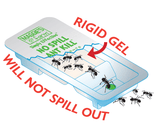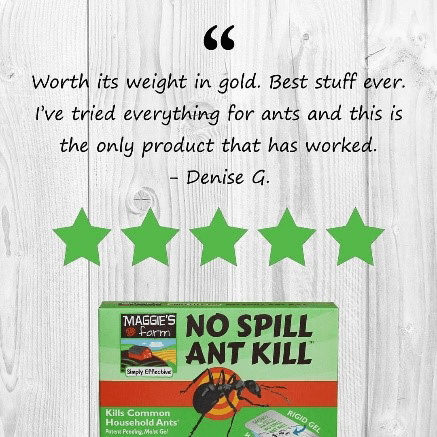Ant season has arrived. Though this could be a bummer, there are ways to keep these pests in check. Baits, like our No Spill Ant Kill, are an effective way to get rid of an ant problem. We've gathered information about baits and made a list of tips to help you control ants in your home.
What is Maggie’s Farm No Spill Ant Kill?
No Spill Ant Kill is a high-moisture borax bait made with a patented rigid gel

formulation. It has the consistency of gelatin and doesn’t spill or drip. Borax is a naturally derived ingredient used in many common household products including soap and laundry detergent.
No Spill Ant Kill’s high-moisture gel remains rigid in temperatures up to 130°F. This means that even on high heat days, ants can walk on top of and feed off the gel bait. They won’t drown in the formulation like they do in liquid baits.
No Spill Ant Kill is effective on common household ants per the product label. Confidently use it in your home, business, and at school, as well as in daycare and elderly care facilities. When used as directed, it’s not harmful to humans or animals.
How Does Ant Bait Work?
Spraying every ant you see may be tempting, but baiting can provide you with longer lasting results. Sprays are great for spot-treating one or two ants, but baits help to target the colony. No Spill Ant Kill contains ingredients designed to attract and kill ants. Foraging ants feed on the bait and carry it back to the nest to share with the colony. As ants eat the bait, the colony dies off. By eliminating the source of the infestation, ants won't return to your house.
5 Tips for Successful Ant Baiting
When used correctly, baits are a simple and effective solution for ants. We’ve made a list of five tips to help you control ants in your house.
1. Find the Ant Trails
Tracking down the problem is the first step to getting rid of ants. Ants have predictable feeding and social habits. Foraging worker ants leave the nest and search for food. In spring, ants emerge after remaining dormant in winter. They are hungry and need to feed the growing colony including the larvae and pupae. Look for ant trails in your home and place baits near them.
Placing bait near ant activity will help ensure ants eat the bait. If you can locate the nest, you’ll want to set stations near it. It’s best to use several stations spread out rather than fewer, clustered placements. Before placing bait, remove any possible food sources for ants including crumbs and spills. Peel the sticker cover off the back and set out the stations. Like all pest control products, it’s best to keep baits away from children and pets.
Common areas for ant activity include:
- Window sills
- Areas with moisture including around tubs and sinks
- Under food cabinets and appliances
- Along baseboards
- Around floor edges and in corners
2. Create a Perimeter Defense

Invading ants often nest outdoors, but they still need nourishment. As worker ants forage for food and moisture for themselves and the rest of the colony, they will inevitably find their way into your home. Placing bait stations around the perimeter of your home can create a perimeter defense. Set stations every 5 to 10 feet around your house near the foundation. Pay special attention to potential entry points. Avoid placing the bait near water. These bait stations can help to stop an infestation before it can begin.
3. Give the Bait Time to Work

It usually takes several days to start seeing results from ant bait. The larger the ant colony, the longer it will take to eliminate it. Baiting is still one of the most effective solutions. If you notice ants around the bait stations, then it’s working. After ants find the bait, they leave pheromone trails so other workers can find it. This is why you’ll see clusters of ants around the stations. The ants need time to take the bait back to the nest. Within a few days of consuming the bait, the ants will die. It typically takes between two to seven days for the bait to run its course, depending on the size of the colony.
If you don’t notice any ants near the stations but are still seeing them in your home, there’s a chance they found a different food source. See if you can locate this food source and remove it. This will help ensure ants aren’t distracted from the bait.
4. Don’t Use Bug Sprays Near Bait

Ant baits attract and kill ants, while some insecticide sprays can repel bugs. Don’t place bait stations on or near places where you’ve sprayed an insecticide. Don’t spray near the stations once placed. This will drive ants away and hinder the effectiveness of the bait stations. You need ants to go to the stations and return to the colony.
5. Watch the Bait Stations
It’s important to check your bait stations regularly to ensure there is always moist bait in them. There are times you’ll need to replace the bait.
- If ants consume all the gel bait, replace the station as soon as possible.
- If the gel bait crystalizes or hardens in the station, add a couple of drops of water to the gel to re-hydrate it.
If you’re dealing with a heavy ant infestation, you may need several bait station replacements.
When ants march into your home, ant baiting can help get rid of them. Our No Spill Ant Kill is an effective and easy-to-use solution. Remember to follow the tips above to help keep ants out of your home. If pests are bugging you, we’re here to help! Check out our Maggie’s Farm Simply Effective™ Pest Control products for a more environmentally and family-friendly solution.






